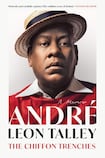
Oh my. Where to begin with this account of the journey of André Leon Talley’s gilded life, accompanied at all times by swathes of Louis Vuitton luggage? Talley, a long-time creative director at Vogue, worked in fashion and glossy magazines his entire adult life, and at 71 still has a bespoke designer shoe in the game.
The Chiffon Trenches recounts half a century of excess in almost every non-essential area of life, which is what makes it such a bitchy and enjoyable read, even if I did need a lie-down afterwards. After all, it’s hard to be a journalist slumming it in 2020 and cycling around town to assignments (me), when Talley’s employers, Condé Nast and other magazines, routinely paid for his “town car” and driver in New York and Paris for years.
Talley initially tried working as a receptionist but it was “too tragic”, as he says with the trademark drama that defines his overwrought writing style. “I was tall, thin, and adored by all who met me,” he writes at one point. Answering phones was never going to cut it as a career for a man who cheerfully admits to being an unapologetic snob and drops famous names like hailstones throughout his memoir.
He was close friends with Karl Lagerfeld for decades, until he was tragically cancelled. He socialised with Andy Warhol, Bianca Jagger, Naomi Campbell, Lee Bouvier Radziwill (sister of Jackie Onassis), Princess Gloria von Thurn und Taxis, Marc Jacobs, Manolo Blahnik and literally dozens of others. (Blahnik wrote the cover blurb.)
Expense accounts
His dedication to fashion led first to a job as Paris correspondent for Women’s Wear Daily (WWD), and then as creative director at American Vogue. It’s the insider descriptions of both this rarefied world of fashion and of working in magazine journalism during an era of astonishing expense accounts that make his memoir such an addictive read.
Fashion houses were run like mini empires. The designers bankrolled their friends, “muses” and, even in the case of Karl Lagerfeld, their antique dealer. It appeared the ethical boundaries all but vanished between designers and the fashion journalists like Talley who covered them.
At one designer’s house, for example, Talley snorts a line of coke “to be polite to my host”. When Lagerfeld invited him to stay at Christmas, he flew him to Paris by Concorde, and had his personal driver meet Talley at the airport to drive to the country mansion. Talley’s Christmas gift was a personalised Fabergé pin with his initials written in diamonds. Another of Lagerfeld’s villas, which Talley often visited, had an Olympic-sized swimming pool where “you could hear music underwater”. All this is breezily related without a shred of embarrassment.
Mind you, Condé Nast itself was crazily extravagant with money towards its staff. In 1988 the company gave him an interest-free loan to buy a house for his grandmother. When he worked for Vogue in Paris, it paid for his grand apartment by Les Invalides, his restaurant bills and his significant dry-cleaning bills, as well as a personal assistant who doubled as his on-call driver. Ah, those were the astounding moneyed days to be a journalist.
Hatchet job
The person who receives almost as much air time in this memoir as Talley is Anna Wintour, his editor at American Vogue, where she still presides. Wintour gets an entire chapter to herself, and she probably needed to have her trademark sunglasses on to hide behind while she read it. Talley was gradually frozen out from his job at Vogue by Wintour, and it’s impossible to read his exposé of her as anything but a form of public revenge.
As a hatchet job it’s pretty spectacular. These are a few samples of very, very many:
“Simple human kindness. No, she is not capable.”
“The Empress Wintour, in her power, has disappointed me in her humanity.”
“There are so many people who worked for her and suffered huge emotional scarring. Women and men, designers, photographers, stylists; the list is endless.”
For years, Talley personally assisted Wintour in her choice of designer outfit and accessories to wear to the Met Ball, to which she alone invites all guests; a night of ultimate “optics” of her power. He annually attended these fittings. “If she asks me to attend her couture fitting after this book is published, I will be surprised,” he writes. Me too!
Aside from all the gossip, name-dropping and insider information in this memoir, we are reminded that Talley was the only prominent black man in fashion journalism from 1988 to the appointment of Edward Enniful as editor of British Vogue in 2017. That disgraceful and unpalatable fact alone makes his story all the more relevant today, and Talley’s achievements so remarkable.










